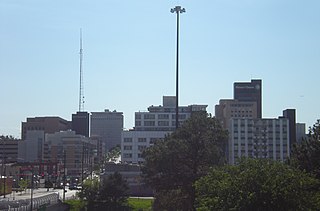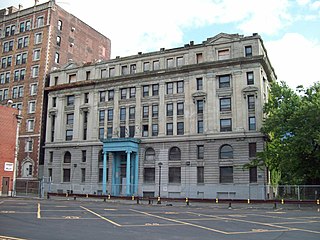
Midtown is a geographic area of Omaha, Nebraska that is a culturally, socially and economically important area of the city. It is home to major research centers, national corporations, several historic districts, and a number of historic residences.

This is a list of the National Register of Historic Places listings in Dakota County, Minnesota. It is intended to be a complete list of the properties and districts on the National Register of Historic Places in Dakota County, Minnesota, United States. Dakota County is located in the southeastern part of the U.S. state of Minnesota, bounded on the northeast side by the Upper Mississippi River and on the northwest by the Minnesota River. The locations of National Register properties and districts for which the latitude and longitude coordinates are included below, may be seen in an online map.
William Lee Stoddart (1868–1940) was an architect best known for designing urban hotels in the eastern United States. Although he was born in Tenafly, New Jersey, most of his commissions were in the South. He maintained offices in Atlanta and New York City.

Berkeley Apartments, also known as the Graystone Hotel, is a historic apartment hotel building located at Buffalo in Erie County, New York.

Parke Apartments, also known as Park Lane Condominium, is a historic apartment building located at Buffalo in Erie County, New York. It was designed and built in 1924-1925 by the H.L. Stevens & Company and is an early 20th-century high class apartment building modestly styled in the Second Renaissance Revival mode. It is a ten-story, concrete framed masonry building built of cream colored brick with light stone detail in a "T" shaped layout. Also on the property is a two-story former carriage house. It was converted from apartments to condominiums in 1977.

Annunciation School is a historic parochial school building located at Buffalo in Erie County, New York. It was built in 1928 and is an "I" shaped brick structure representative of standardized, modestly sized school buildings of the period. It was operated by the Sisters of St. Mary of Namur. The school was closed as a parish school in 1988. It was home to the Catholic Academy of West Buffalo until 2005 and was converted to apartments in 2009–2010.

There are 70 properties listed on the National Register of Historic Places in Albany, New York, United States. Six are additionally designated as National Historic Landmarks (NHLs), the most of any city in the state after New York City. Another 14 are historic districts, for which 20 of the listings are also contributing properties. Two properties, both buildings, that had been listed in the past but have since been demolished have been delisted; one building that is also no longer extant remains listed.

Charles Erastus Colton was an American architect who worked in Syracuse, New York.

Kensington Gardens Apartment Complex is a historic apartment complex located at Buffalo in Erie County, New York. It was built in 1941–1942 and is a multi-unit apartment complex containing a total of 280, one-, two- and three-bedroom apartments in a variety of detached and semi-attached buildings in the Colonial Revival style. The 59 contributing buildings are grouped around grassed courts. There are 10 court areas created on the site and three building types within courts. It is an example of a World War II-era worker housing community built with financing by the Federal Housing Administration (FHA).

Public School 17 is a historic school located at City Island in the Bronx, New York City. It was designed by architect C. B. J. Snyder (1860–1945) and built in 1897 in the Neo-Georgian style. A rear addition was built in 1930. It is a two-story, five-bay brick building on a high basement. It features a shallow wooden entrance porch with Doric order columns.

The Astral Apartments is an apartment building located at 184 Franklin Street in Greenpoint, Brooklyn, New York City. The Astral was built in 1885–1886 as affordable housing for employees of Charles Pratt's Astral Oil Works. It is a block-long brick and terra cotta building in the Queen Anne style. It features a central projecting section with a deep, three-story-high round arch recess. The roof features inward-looking decorative grotesques. Original amenities of the building included a settlement house, library, and kindergarten.

Rockwood Chocolate Factory Historic District is a historic industrial complex and national historic district in Fort Greene, Brooklyn, New York City. The complex consists of 16 contributing buildings built between 1891 and 1928. The largest and oldest building dates to 1891 and is located at the corner of Washington and Park avenues. It is a five-story, Romanesque Revival style building. Much of the complex has been converted to loft apartments.

The New Kasson Apartments is a historic apartment building located on James Street in the Near Northeast neighborhood of Syracuse, Onondaga County, New York. It was designed by architectural firm of Merrick and Randall and built in 1898. It is a seven-story, Renaissance Revival style building consisting of two rectangular multi-story blocks. It is a yellow brick and limestone building with cast stone and terra cotta details. The facades features projecting three-sided bays extending from the first through fifth floors. It is located across from the Leavenworth Apartments built in 1912.

Sibley and Holmwood Candy Factory and Witkop and Holmes Headquarters, also known as the Weed & Company Building, are two connected historic commercial buildings located in downtown Buffalo, Erie County, New York. The Sibley & Holmwood Candy Factory was built in 1896 and is a five-story, nine-bay-wide brick commercial block with late-Gothic detailing. It features Gothic window arches, decorative cast-iron columns on the storefront, and corbelled cornice. The Witkop & Holmes Headquarters was designed by the architectural firm Bethune, Bethune & Fuchs and built in 1901. It is a four-story, three-bay-wide brick commercial block. Both buildings have flat roofs. The building has been renovated to house loft apartments.

Public School No. 60, also known as Riverside Academy, is a historic school building located in the Riverside neighborhood of Buffalo, Erie County, New York. The original section was built in 1898, and is a three-story, 12 bay, "I"-plan red brick building with Renaissance Revival detailing. It sits on a raised basement and features polychrome, stepped façade, quoining, and classical entrances. A substantial three-story rear addition was built in 1922 and includes an auditorium. The building has been converted to accommodate 68 units of affordable housing.

Heyworth–Mason Industrial Building is a historic factory located in Peru, Clinton County, New York. It was built in 1836, and is a three-story, seven bay, rectangular, sandstone building measuring 35 feet wide and 60 feet long. It has a gable roof and interior end chimneys. It originally housed a factory and later storage. It was converted to apartments in the 1970s.

Hotel Albert, also known as The Albert and Albert Apartments, is a historic hotel and apartment complex located in the Greenwich Village neighborhood of Lower Manhattan, New York City. The Albert began with three row houses at 32-36 East 11th Street, off of University Place, which were turned into the St. Stephen Hotel in 1876–1877 to designs by designed by James Irving Howard. The owner, Albert S. Rosenbaum, then commissioned architect Henry Janeway Hardenbergh to build 24 "French flats" between the hotel and University Place. Completed in 1883, they were converted into the Hotel Albert in 1886–1887. An additional story was added in 1891, and the two hotels merged in the mid-1890s. In 1903–1904, a 12-story building was added to the south at 67 University Place, designed by Buchman & Fox, and in 1922–1924 a six-story building on the corner at 23 East 10th Street, designed by William L. Bottomley and Sugarman, Hess & Berger, while the St. Stephen was given an entirely new facade in the 1920s, and let go for commercial lease. In 1977 the entire complex, including the St. Stephen, was converted to rental apartments as The Albert. It was then converted to a co-op in 1984. The hotel was noted for being popular among artists, writers, and political radicals.

116 John Street is a historic office tower at the southwest corner of John Street and Pearl Street in the Financial District of Lower Manhattan in New York City. It was built in 1931, and is a 35-story brick and terra cotta building consisting of a three-story base, a 19-story shaft, and 12 upper stories that recede in a series of setbacks. The building features Art Deco style design elements at the recessed entrances and in the lobby. Built as a speculative office building for insurance companies, the building interior was rehabilitated in 2013 and some floors converted to apartments.

The Chadwick was a historic apartment building located at Indianapolis, Indiana. It was built in 1925, and was a three-story, five bay, "I"-shaped, Georgian Revival style buff brick building with limestone detailing. It featured Tuscan order engaged columns at the entrance. It was destroyed by fire in January 2011.

The Rae Flats and The Raleigh, also known as The Phoenix; The Hotel Raleigh; The Tudor Arms; The Phoenix Apartments, are two historic apartment buildings located in the Allentown neighborhood of Buffalo, Erie County, New York. The Rae was built about 1892, and is a three-story, polychromatic brick building over a raised basement with Norman inspired detailing. The Rae houses a total of seven apartments. The Raleigh was built about 1896 as a Jewish clubhouse and converted to apartments in 1901. It is a four-story, Romanesque Revival style brick building that houses 28 apartments.























